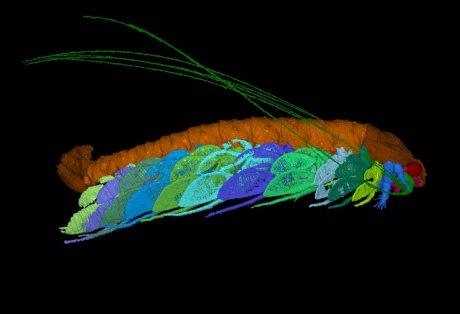The team, from the University of Leicester, Imperial College London and the universities of Oxford and Yale, have named the ancient crustacean Cascolus ravitis, in honour of Sir David Attenborough who is celebrating turning 90 this year.
The name ‘Cascolus’ is derived from the Old English source for the surname Attenborough.
The researchers discovered Cascolus ravitis in Herefordshire in the Welsh Borderlands, entombed in volcanic ash deposits. It lived during the Silurian Period, some 430 million years ago. This was a period of time when Britain was located in a completely different position, in the warm southerly subtropical latitudes. Herefordshire was covered by a shallow sea, close to an ancient continent that is roughly equivalent to modern North America. The find is detailed in a new study in the journal Proceedings of the Royal Society B.
Dr Mark Sutton, the co-author of the study from the Department of Earth Science and Engineering at Imperial, said: “The Silurian Period was a time when life on Earth was mostly based in the seas, and plants and creatures were only just beginning to appear on land. The seas would have been teeming with a range of animals including ancient ancestors of crustaceans, like Cascolus ravitis.”
Cascolus ravitis is a distant relative of modern day crustaceans, which include lobsters, shrimps and crabs. The creature is tiny, around nine millimetres in length. It has been exceptionally well preserved as a fossil, complete with the soft parts of the creature including the legs, eyes and even its’ delicate antennae. The team say it is very rare for the soft parts of creatures to be preserved, and particularly rare for them to be preserved so perfectly in three dimensions.
Dr Sutton said: “The fossil deposits in Herefordshire have given us a dazzling array of scientifically significant finds over the years, but none are more spectacular or exquisitely preserved than Cascolus ravitis. However, this fossil is not just a pretty face. It has provided us with anatomical information from the early evolutionary history of the ancestors of modern crustaceans such as how their respiratory system and legs have developed over time. This sort of data is gold dust as fossils of this quality can tell us things about evolutionary events hundreds of millions of years ago that we just can’t find out any other way.”
Cascolus ravitis is named in honour of Sir David, who grew up on University College Leicester campus – the forerunner to the University of Leicester. His father was the principal.
‘Ravitis’ is a combination of ‘ratae’, the Roman name for Leicester, ‘Vita’, which means life, and ‘commeatis’, the Latin word for a messenger.
Dr Sutton added: “We hope Sir David will be very happy to be associated with such a scientifically significant and visually eye-popping animal.”
Agencies/Canadajournal
 Canada Journal – News of the World Articles and videos to bring you the biggest Canadian news stories from across the country every day
Canada Journal – News of the World Articles and videos to bring you the biggest Canadian news stories from across the country every day



